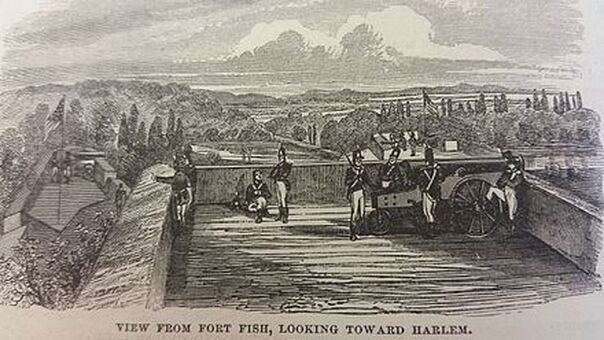 While we celebrate July 4th--Independence Day--with fireworks and barbecues, America's Revolutionary War still can seem like an event in the distant past. After all, 1776 was 243 years ago. Yet, traces of the war are apparent, vestiges written into, if not shaped by, the topography of the landscape itself--even in New York City. Central Park's steep bluffs overlooking the Harlem Meer were important strategic features during the American Revolution, their elevation and expansive views providing the site for the military fortifications Fort Fish, Fort Clinton, and Nutter's Battery, sites still on view today. During America's War of Independence, George Washington defended New York against invading British forces from this high-ground position that is now the northeast section of Central Park. The British defeated Washington in the area and built a series of fortification extending from the bluffs to the Hudson. In addition to Fort Fish, Fort Clinton, and Nutter's Battery, the British constructed a chain of blockhouses, the site of one of which is in Central Park's Northwoods, adjacent to 109th Street. Each of these locations was subsequently used by Americans to defend against the threat of British invasion from the north during the war of 1812. McGowan's Pass was another key topographic feature during the Revolutionary War in what is now Central Park. Located along the steep hill and switchbacks of what is now the park's East Drive north of 102nd street, it was a Hessian (conscripted German soldiers) encampment for much of the war, from 1776 to 1883. At the war's end, the Hessians and British retreated north through pass, while George Washington reentered New York through the pass. Gazing at today's runners and cyclists traversing topographies of Central Park that during the Revolutionary War were strategic locations suggests more than weekend warriors. One can, with a little imagination, time travel and conjure warriors of the American Revolution traversing the same terrain and making use of its features. Landscapes carry memory.
0 Comments
Leave a Reply. |
About this Blog
Hi! I'm Nancy Kopans, founder of Urban Edge Forest Therapy. Join me on an adventure to discover creative ways to connect with nature in your daily life, ways that are inspired by urban surroundings that can reveal unexpected beauty, with the potential to ignite a sense of wonder. Archives
April 2023
Categories
All
|

 RSS Feed
RSS Feed